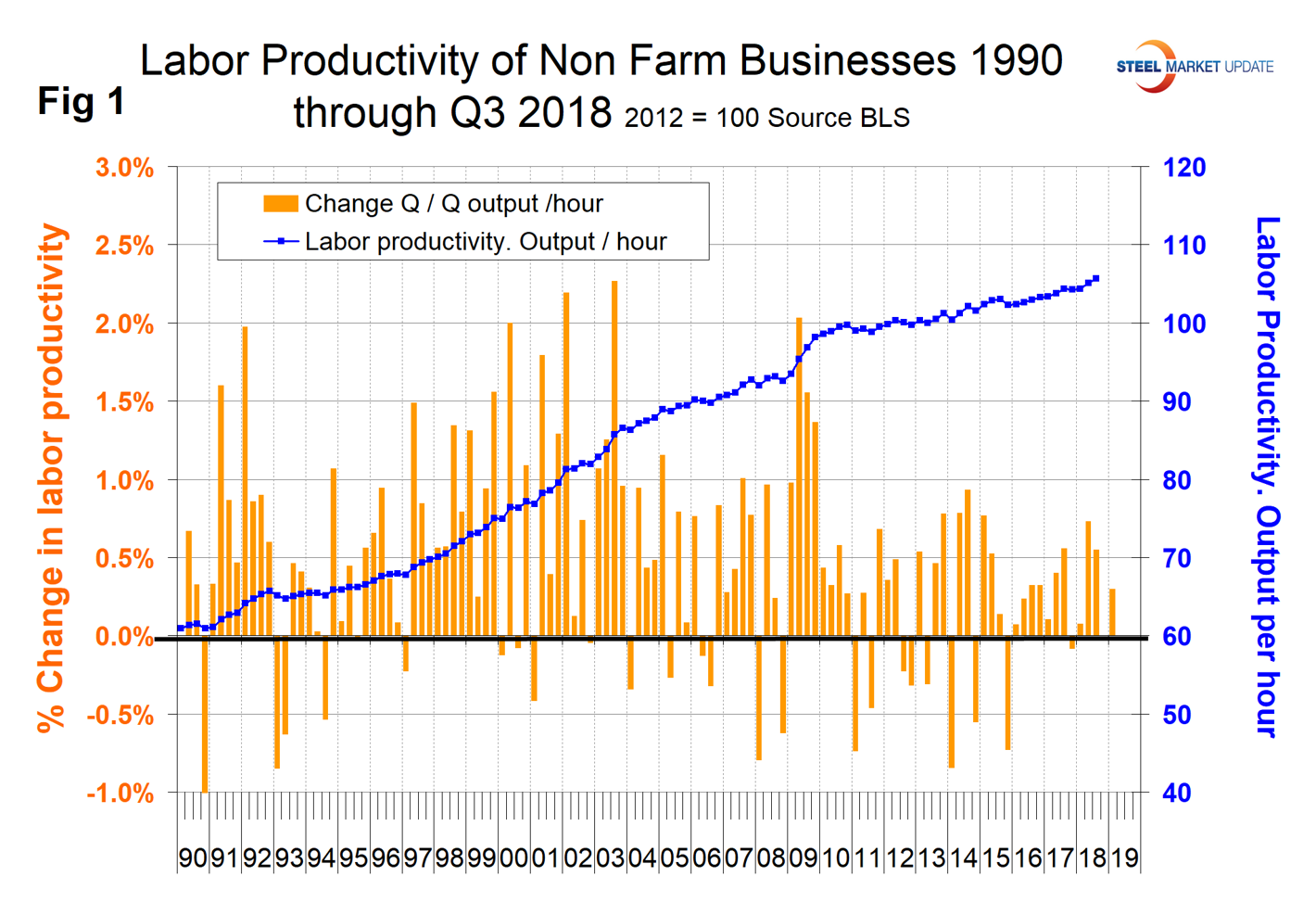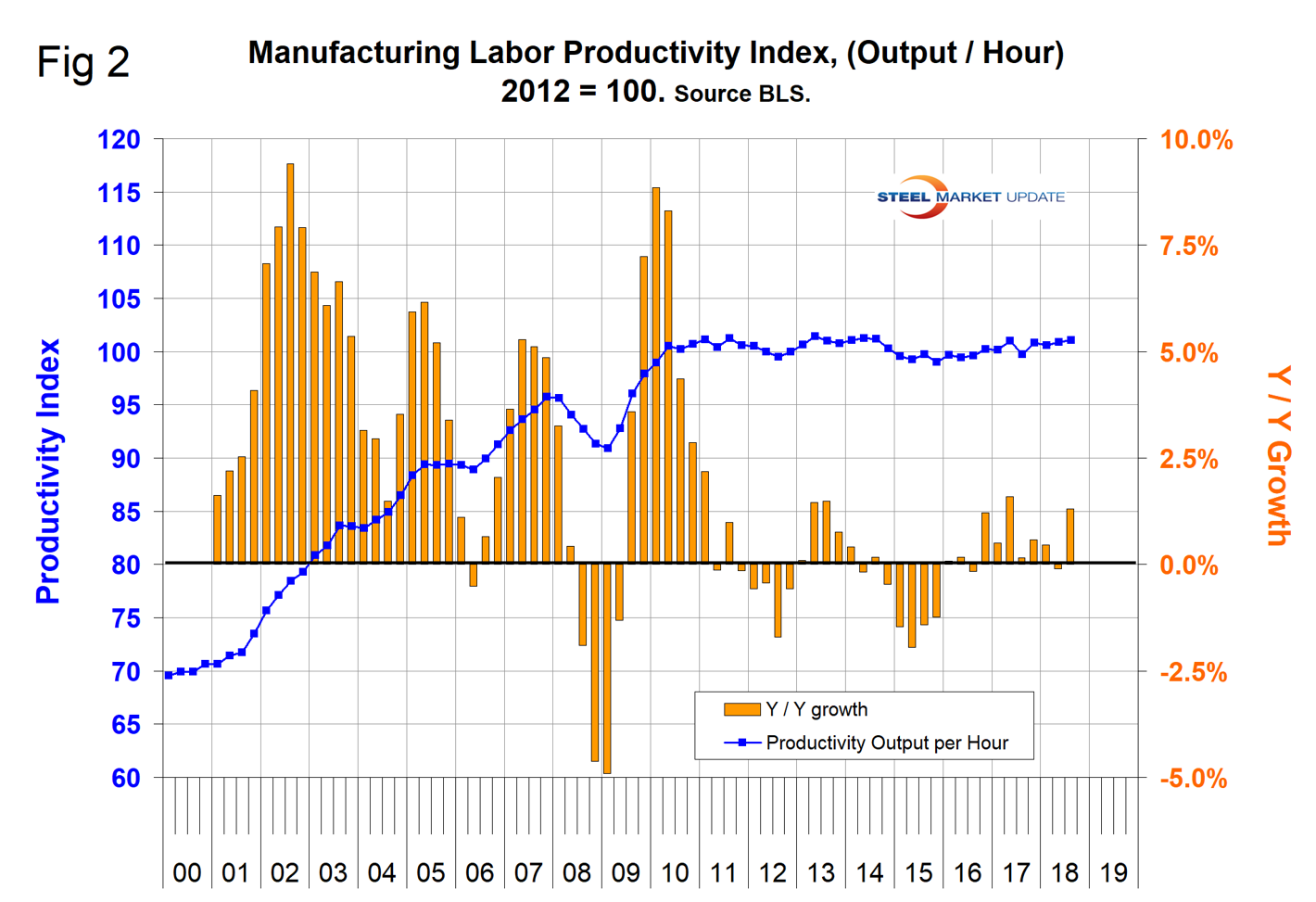SMU Data and Models

SMU Labor Analysis: Productivity Improves in Q3
Written by Peter Wright
November 7, 2018
Labor productivity grew by 0.5 percent in the third quarter of 2018. The average of the last three quarters has been 0.3 percent. Unit labor costs increased 1.2 percent year over year, according to Steel Market Update’s latest analysis of Bureau of Labor Statistics (BLS) data.
Unit labor costs and productivity changes are reported quarterly by the BLS and results for Q3 2018 were released last week. All quarterly percent changes in this release are seasonally adjusted annual rates. This basic information is useful to better understand the steel market. One way of looking at GDP is that it is the growth of the working age population multiplied by their productivity. Steel consumption is correlated with the growth of GDP.
Figure 1 shows labor productivity in output per hour as an index based on 2012 = 100 and the quarterly change for nonfarm businesses in total. Labor productivity, or output per hour, is calculated by dividing an index of real output by an index of hours worked by all persons, including employees, proprietors and unpaid family workers. Through Q1 this year, productivity had been trending up but has reversed course in Q2 and Q3. On a longer term basis since Q1 2017, the average quarterly improvement has been 0.30 percent. In Q3 2018, the improvement was 0.55 percent.

The manufacturing component of the big picture had a poor productivity performance in the four quarters Q3 2017 through Q2 2018 with an average gain of only 0.27 percent. This improved to 1.3 percent in Q3 2018 mainly because Q3 2017 was an outlier to the low side. Figure 2 shows the productivity index for manufacturing industries with the year-over-year gain. The productivity growth of manufacturing has been stalled for 8½ years following the post-recessionary recovery.

In the third quarter, unit labor costs increased by 1.2 percent with a 4Q moving average of 1.48 percent. BLS calculates unit labor costs as the ratio of hourly compensation to labor productivity. Increases in hourly compensation tend to increase unit labor costs, and increases in output per hour tend to reduce them. The 4Q MA has declined every quarter since Q3 2017. Figure 3 shows the change in unit labor costs since Q1 2000.


Peter Wright
Read more from Peter WrightLatest in SMU Data and Models

SMU Survey: Buyers’ Sentiment rebounds from multi-year low
Both of SMU’s Steel Buyers’ Sentiment Indices edged higher this week. Current Sentiment rebounded from a near five-year low, while Future Sentiment rose to a two-month high

SMU flat-rolled market survey results now available
SMU’s latest steel buyers market survey results are now available on our website to all premium members.

SMU Survey: Sheet lead times pull back after early-June blip, plate holds
Following the uptick seen two weeks ago, lead times eased this week for all four sheet products tracked by SMU, while plate lead times held steady, according to this week’s market survey.

SMU Survey: Pricing power abruptly shifts to steel buyers
The majority of steel buyers responding to our latest market survey say domestic mills are more willing to talk price on sheet and plate products than they were earlier this month. Sheet negotiation rates rebounded across the board compared to early June, while our plate negotiation rate hit a full 100%.

Service centers: Mill orders down marginally in May
SMU’s Mill Order Index (MOI) declined for a third straight month in May, but only marginally.
